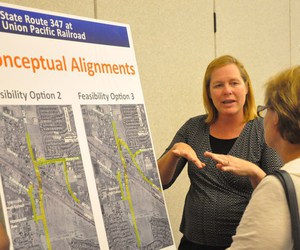
It was standing room only at the Maricopa Unified School District administrative offices Thursday evening as Arizona Department of Transportation officials presented various plans to re-route State Route 347 to create a bridge over the intersecting railroad tracks and remove the need for motorists to stop when a train passes through the city.
According to ADOT, predicted future traffic shows up to 67,000 vehicles driving on State Route 347 in a given day. The daily number of trains crossing through Maricopa could reach up to 100 – 60 more than today.
Any overpass would need to be at least 23.5 feet to allow Union Pacific trains to pass under. And, to prevent future construction in case railroad services expand, accommodations for four tracks must be made.
A study was commissioned last July to see what could be done about any major traffic congestion created by an increase in railroad activity coupled with the growth seen in Maricopa’s future.
“We don’t want to design something that will shut down State Route 347 for five to six months,” ADOT Consultant Project Manager Elijah Williams told the crowd. “That would impact business and cause delays on the road that wouldn’t help anybody.”
ADOT presented 10 options to the public and identified the top three from a rating scale that took environmental, cultural, business and traffic impacts as well as the amount of time needed for construction.
A fourth option, moving the Amtrak rail station further from the city, is being considered by the city but would be funded by the city itself, said ADOT spokesman Dustin Krugel.
Mayor Christian Price said, “In a perfect world, we could move the station next year, but there are a lot of variables there.”
One option would create a small eastbound curve on SR 347 to a more open area to cross the tracks. Under the plan, Edwards Avenue no longer would connect to SR 347 and drivers would have to go south to Honeycutt Avenue to reach the state route. Drivers wishing to exit onto the Maricopa-Casa Grande Highway from SR 347 would have to take Honeycutt Road before connecting to the highway.
Another option would move SR 347 slightly to the east to become a straight shot south while connecting to Honeycutt Avenue. Honeycutt Road would connect further north and swoop down to connect to Maricopa-Casa Grande Highway.
The third alternative would look similar to the second option but create a two-lane one-way road that detaches and then cross over SR 347 to connect to the Maricopa-Casa Grande Highway; cutting out the need for a left-turn that could cause congestion.
One of the most talked about points of the project is its funding. The city of Maricopa has set aside $10 million and has received a $300,000 grant from the Gila River Indian Community. The project would cost between $50 million to $60 million, Williams said.
The city currently is seeking federal grant money for the project. Last month, the Maricopa city council authorized staff to submit an application to a U.S. Department of Transportation grant program for an amount of no more than $62 million.
Before construction can begin, the project would need to be placed on ADOT’s five-year construction program schedule, which lists future projects and funding for the state’s transportation infrastructure.
“We can’t just say to ADOT, ‘give us $100 million’ when there is only $500 million allocated to the state as a whole. It’s not going to happen,” Price said. “Once we get on ADOT’s five-year plan, get some help from Ak-Chin … and get some from Pinal County, we’re golden.
“You have to look at it like 347 is an ADOT road but the road is not solely their responsibility.”
***ADVERTISEMENT***
Some residents who came to the presentation expressed concern on how businesses and homes would be impacted by the proposed plans.
“I want to know why leaving 347 is not an option for the people that live off it now,” said Bret Roberts, who lives in Senita. “I came here to see what all the options were, and to see what they were looking for. Some of the people here have businesses that got to be moved.”
“In the case that someone will have their business impacted, they would work with our Right of Way Group to get assistance,” Krugel said. “We follow the federal rules and regulations regarding this.”
“That is one of the cities main concerns,” Price said. “This is not meant to destroy business, it’s meant to build it.”
One meeting attendee asked Williams why creating a tunnel underneath the train tracks was not an option. Williams acknowledged the idea has been proposed before.
“This is an exciting thing for us,” Price said. “If we can get this funding down and decide on a plan with ADOT, it’ll be great.”

![Maricopa’s ‘TikTok Rizz Party,’ explained One of several flyers for a "TikTok rizz party" is taped to a door in the Maricopa Business Center along Honeycutt Road on April 23, 2024. [Monica D. Spencer]](https://www.inmaricopa.com/wp-content/uploads/2024/04/spencer-042324-tiktok-rizz-party-flyer-web-218x150.jpg)



![Locals find zen with Earth Day drum circle Lizz Fiedorczyk instructs a drum circle at Maricopa Community Center April 22, 2024. [Brian Petersheim Jr.]](https://www.inmaricopa.com/wp-content/uploads/2024/04/PJ_3922-Enhanced-NR-218x150.jpg)


![Shred-A-Thon to take place tomorrow An image of shredded paper. [Pixabay]](https://www.inmaricopa.com/wp-content/uploads/2024/03/shredded-paper-168650_1280-218x150.jpg)



![Alleged car thief released without charges Phoenix police stop a stolen vehicle on April 20, 2024. [Facebook]](https://www.inmaricopa.com/wp-content/uploads/2024/04/IMG_5040-218x150.jpg)
![MHS G.O.A.T. a ‘rookie sleeper’ in NFL draft Arizona Wildcats wide receiver Jacob Cowing speaks to the press after a practice Aug. 11, 2023. [Bryan Mordt]](https://www.inmaricopa.com/wp-content/uploads/2024/04/cowing-overlay-3-100x70.png)


